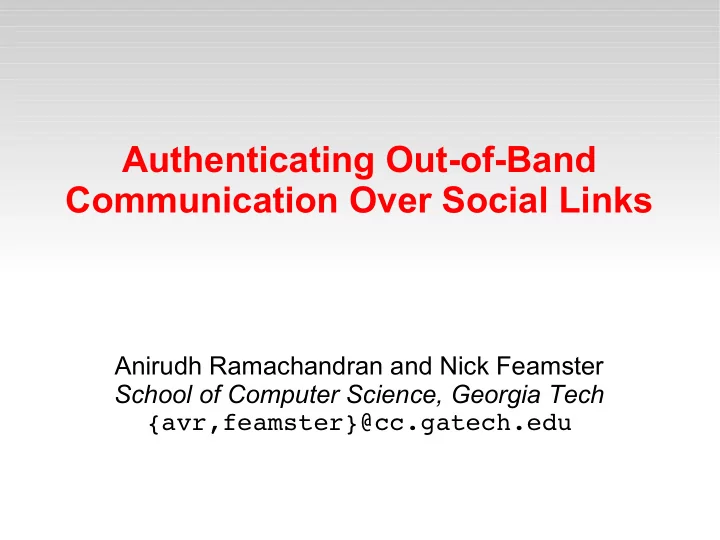

Authenticating Out-of-Band Communication Over Social Links Anirudh Ramachandran and Nick Feamster School of Computer Science, Georgia Tech {avr,feamster}@cc.gatech.edu
Motivating Application: Secured Web Server Bob Alice Alice wishes to set up a secure web service to share her photos only with her friends. She must Trudy 1.Distribute the URL of the service to her friends What if the server is unreachable or its IP / location changes (e.g., DHCP)? 2. Create and distribute credentials for the service to each friend Email/IM: What if she wants to add or revoke friends?
How can Online Social Networks help? Social networks store and manage a user's friends Expresses real-life relationships online Security based on social relationships is exactly what many applications need Challenge : How can we leverage relationships on OSNs for securing inter-app communication?
Securing a Web server using OSNs “ Buddies ” Create friend group Log in 1. 2. Alice Group Name : Buddies Permissions: Members Only Publish service details 3. Alice's server IP: 100.1.1.1 Bob Alice's password: '' insecure'' to group Status : Online Get Alice's server credentials 4. 5. Alice's Server Present credentials to Alice's server If only applications could do this automatically...
Our Contribution: Authenticatr Alice's application 1. Exchange IPs 2. Open Ports 3. Set up keys Social Authenticatr Networking Bob's Application Trust in real life Trust on OSNs Trust on the Internet Requirements for the social networ k ➔ The social network must be authenticated ➔ It must support basic messaging between friends
Design Overview Three components Secure File Conduct Webserver Sharing Measurement A set of applications that Applications using can use social context Social Authentication for authentication Authenticatr API A set of social communication Supported Social Networks protocols An API that exports a uniform interface to all applications. “Hourglass” design
Outline Motivating Application #2: P2P file sharing Authenticatr API File Secure Conduct Sharing Webserver Measurement More Applications! Applications using Ongoing and Future Work Social Authentication Authenticatr API Related Work Summary Supported Social Networks
Motivating Application #2: P2P sharing Alice wishes to securely share large files with some of her friends ✗ Send it via email or IM : file size limits; Alice must initiate each file transfer; friends cannot be added or removed ✗ Share it on a P2P network (e.g., Gnutella) : No security (or Alice must password-protect the files, and distribute the file names and keys to each friend) All of peer discovery, secure communication, and scalability are difficult to achieve
P2P Filesharing with Authenticatr Log In Present credentials Retrieve list of friends Alice P2P client over Authenticatr Choose files to share Wait for connections Choose friends Exchange IPs, password, etc. Present credentials using social messaging Initiate direct connection Present credentials Bob's P2P client Bob
Authenticatr API Goal Function Prototype Authentication Attempt to log onto network n, API session* login (network *n, returning a session handle credential *cred) Communication Send an opaque message msg to send (session *s, friend *f, friend f using session s message *msg) API Receive opaque message msg from recv (session *s, friend *f, friend f over session s message **msg) functions Utility Get the list of friends of user f from get_friends (session *s, session s as the list l friend *f, friend **l)
More Applications! Alice wants to conduct a network measurement from Bob's computer Alice's application: s = login (facebook, 1.Alice's application logs in and cred_alice); get_friends_list (s, NULL, inspects Bob's profile to see if his &friend_list); application is active send (s, friend_list[1], ”ping google.com”); 2.Alice's app sends a message to Bob Periodically: recv (s, friend_list[1], such as “ ping google.com ” &meas_response); 3.Bob's app picks up the message, conducts the experiment, and sends Bob's application: recv (s, friend_list[2], the result back as another message &meas_request); May be used for root-causing network // Perform measurement send (s, friend_list[2], disruptions meas_response);
Application: Key exchange Alice and Bob want to negotiate a shared secre t 1.Alice and Bob set up Diffie-Hellman parameters in a set of messages over the social network of choice 2. Using D-H, a key can be established in one more roundtrip
Practical Considerations Changes to host applications : mainly user input Retrieves user/pass from social network instead of prompting the user Session Multiplexing : many application instances must use one social network session Each message passed on the social network contains identifying tags (similar to an object broker)
Ongoing and Future Work Two applications: secured web service and a P2P filesharing service Two social networks: Google Talk and Facebook Challenges: Facebook does not provide a way for desktop applications to send or receive messages Using notifications as a hack Can only get “unread” notifications Message ordering/timestamping, locking Discussion topic: Wishlist for OSN APIs?
Related Work OpenSocial : Attempts to unify social networks for web- based applications Authenticatr unifies social networks for desktop apps; also can work across IM, mailing lists, etc. Lockr: Attempts to reuse social relationships from one DB/service on other services for access control SocialGraph : Similar goal, except it uses publicly declared relationships (no security) Authenticatr does not try to combine two social networks; provides a uniform interface for each (to apps) FriendStore , Pownce : Share files within friend networks Authenticatr extends and generalizes this idea
Summary Many desktop applications could benefit from secure communication Many, however, forsake it for usability Social networking channels offer a secure messaging path to initiate authentication Implements real-world trust relationships online Authenticatr allows desktop applications to use these social channels for authentication
Thanks! Coffee, anyone?
Recommend
More recommend